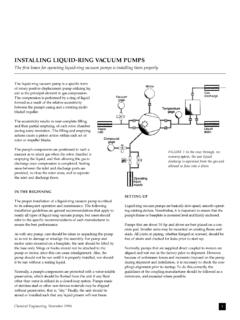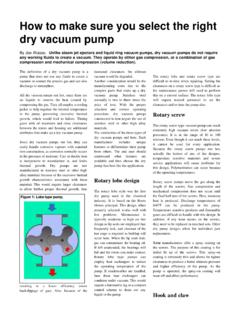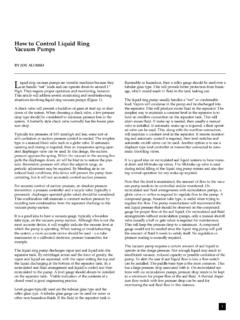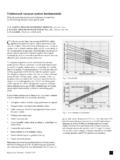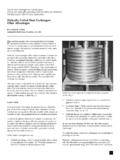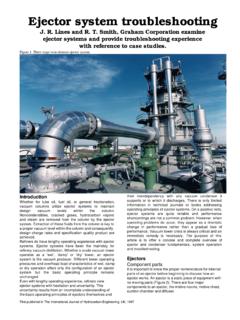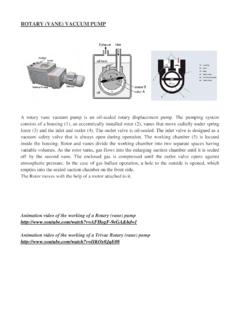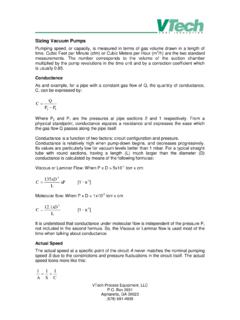Transcription of Choose the Right Vacuum Pump - Graham Corporation
1 Choose the Right Vacuum PumpJoe Aliasso, Graham CorporationReprinted from CHEMICAL ENGINEERING, March 1999, copyright 1999 by the McGrawHill Companies with all rights reprints may be ordered by calling Chemical Engineering Reprint Department (212) need to operate under Vacuum iswidespread throughout the chemical processindustries (CPI). Distillation, drying, flashcooling, stripping, and evaporation are amongthe unit operations that frequently take placeat less than atmospheric many process applications, the overridingconsideration is the amount of Vacuum (ordegree of evacuation) required. Of the fivemajor types of Vacuum producing devicesdiscussed here, the ejector can achieve thegreatest degree of evacuation: down to 5micrometers of Hg absolute.
2 Dry pumps androtary piston pumps can each evacuate to 10micrometers Hg; once-through oil pumps canreach 500 micrometers Hg; and liquid ringpumps can go down to 10 mm from its Vacuum producing ability, eachof the five types has its own set of attractionsand drawbacks. Many of these depend on theparticular are workhorsesThe simplest and probably most widely usedvacuum producer is the ejector (Figure 1).Sometimes called a jet pump, an ejector worksby converting pressure energy of a motive fluid(which may be the same as or different fromthe process fluid) into velocity energy (kineticenergy) as it flows through a relatively smallconverging-diverging nozzle.
3 This loweredpressure of the motive fluid creates suction in amixing chamber, into which the process fluid isdrawn from the vessel being evacuated. Theprocess fluid mixes with and becomesentrained in the motive fluid stream. Thismixed fluid then passes on through aconverging-diverging diffuser, where thevelocity is converted back to pressure resultant pressure is higher than thesuction pressure of the use many types of motive is the most common. Other popularchoices include ethylene glycol, air, nitrogen,and vaporized organic solvents. To avoidcontamination and other problems, it isimportant to Choose a motive fluid compatiblewith the process offer a range of attractions:lSimple design, with no moving parts andpractically no wearlCan be mounted in any orientationlCan be fabricated of virtually any metal, aswell as various types of plastics.
4 The latter areusually fiber reinforced gradeslLowest capital cost among vacuumproducing deviceslOffers the largest throughput capacity of anyvacuum producing device - can handle morethan 1,000,000 ft3/min of process fluidlNo special startup or shutdown proceduresrequiredlCan handle condensable loadslSimple repair and the other hand, there are also disadvantagesto ejectors:lThe requirement of a pressurized motivefluidlThe inevitable contamination of the motivefluid by the process gas, and vice versalCan be noisy; may require discharge silencersor sound insulationlIn most cases, the need for a cooling liquidsource to condense the mixture of motive andprocess-fluid vaporsEjectors are especially attractive when theprocess load contains condensable or corrosivevapors, very low absolute pressures areneeded, or the Vacuum producing capacityrequired is very large.
5 However, these devicesare not confined to such applications; theyshould also be evaluated, along with otheroptions discussed below, in other also work well as boosters upstreamof liquid ring pumps (below). Thiscombination can minimize capital and utilitycosts with no sacrifice in in any nozzle, the phenomenon known ascritical flow can arise with an ejector. Roughlyspeaking, critical flow prevails when thedischarge pressure is at least twice the suctionpressure. Under these circumstances, astanding shock wave is set common misconception arises with regard tocritical flow: that if the discharge pressure isreduced, the suction pressure of the ejector willdecrease and thus a higher Vacuum will becreated.
6 This is not possible, because the shockwave isolates the inlet conditions from thedischarge conditions. An alternative way forthe Vacuum level of the ejector to be increasedis by putting less load to it. Usage of ejectorsthroughout the CPI is wide. Examples include: Vacuum distillation in petroleum refineriesSeveral devices are available forproducing Vacuum at a chemical-process has its own advantages and drawbacksand chemical, plastics, pharmaceuticals andsynthetic fibers plants; refrigeration at pulpand paper mills; drying in chemical andpharmaceutical plants; drying, flash coolingand refrigeration at food plants; and productdegassing in steel mills.
7 A related widespreaduse is condenser air venting at power ring pumps arecoolAnother Vacuum producing device that canevacuate vessels containing condensable orotherwise wet loads is the liquid ring vacuumpump (Figure 2). In its approximatelycylindrical body, a sealant fluid undercentrifugal force forms a ring against the insideof the concentric source of that force is a multi-bladedimpeller whose shaft is mounted so as to beeccentric to the ring of liquid. Because of thiseccentricity, the pockets bounded by adjacentimpeller blades (also called buckets) and thering increases in size on the inlet side of thepump, and the resulting suction continuallydraws gas out of the vessel being evacuated Asthe blades rotate toward the discharge side ofthe pump, the pockets decrease in size and theevacuated gas is compressed, enabling ring of liquid not only acts as a seal; it alsoabsorbs the heat of compression, friction andcondensation.
8 In principle virtually any typeof liquid can be used, so long as it is not proneto vaporization (and thus to cavitation) at theprocess conditions. Popular choices includewater, ethylene glycol, mineral oil and organicsolvents. Assuming that the evacuated processvapor does not react with or dissolve in thesealant liquid, contamination is minimized andthe condensed process fluid is available forreuse in the advantages of liquid ring Vacuum pumpsare as follows:lSimpler design than most other vacuumpumps; employs only one rotating assemblylCan be fabricated from any castable metallMinimal noise and vibrationlVery little increase in the temperature of thedischarged gaslCan handle condensable loadslNo damage from liquid or small particulatesentrained in the process fluid lMaintenanceand rebuilding are simple compared to mostother Vacuum pumpslInherently slow rotational speed (1,800rev/min or less), which maximizes operatinglifelCan be started and stopped over and overlCan use any type of liquid for the sealantfluid, in situations where mingling with theprocess vapor is permissibleThe drawbacks of liquid-ring Vacuum pumpsare as follows.
9 LInevitable mixing of the evacuated gas withthe sealing fluidlRisk of cavitation, which requires that aportion of the process load be noncondensableunder the pump operating conditionslHigh power requirement to form andmaintain the liquid ring, resulting in largermotors than for other types of pumpslAchievable Vacuum is limited by the vaporpressure of sealant fluid at the operatingtemperature The liquid-ring pump is especiallyattractive when the process load containscondensable vapors, or if liquid carryover ispresent (due either to normal operation orprocess upsets), or if cool running operation isrequired due to flammable or temperaturesensitive process fluids.
10 However, thesedevices may also prove to be the best choicefor other process condensable process fluids, the choicebetween a liquid-ring pump and an ejectorusually depends on the nature of thecustomer s business. Ejectors offer the lowercapital cost, but the liquid-ring models areordinarily less expensive to , for example, a customer with aready source of inexpensive steam for use asmotive fluid might favor the (medium Vacuum ) versions of theliquid-ring pump can evacuate up to 20,000ft3/min. Two-stage (high- Vacuum ) versionsevacuate up to 7,000 ft3 ejectors, liquid-ring Vacuum pumps arewidely employed in the CPI.

